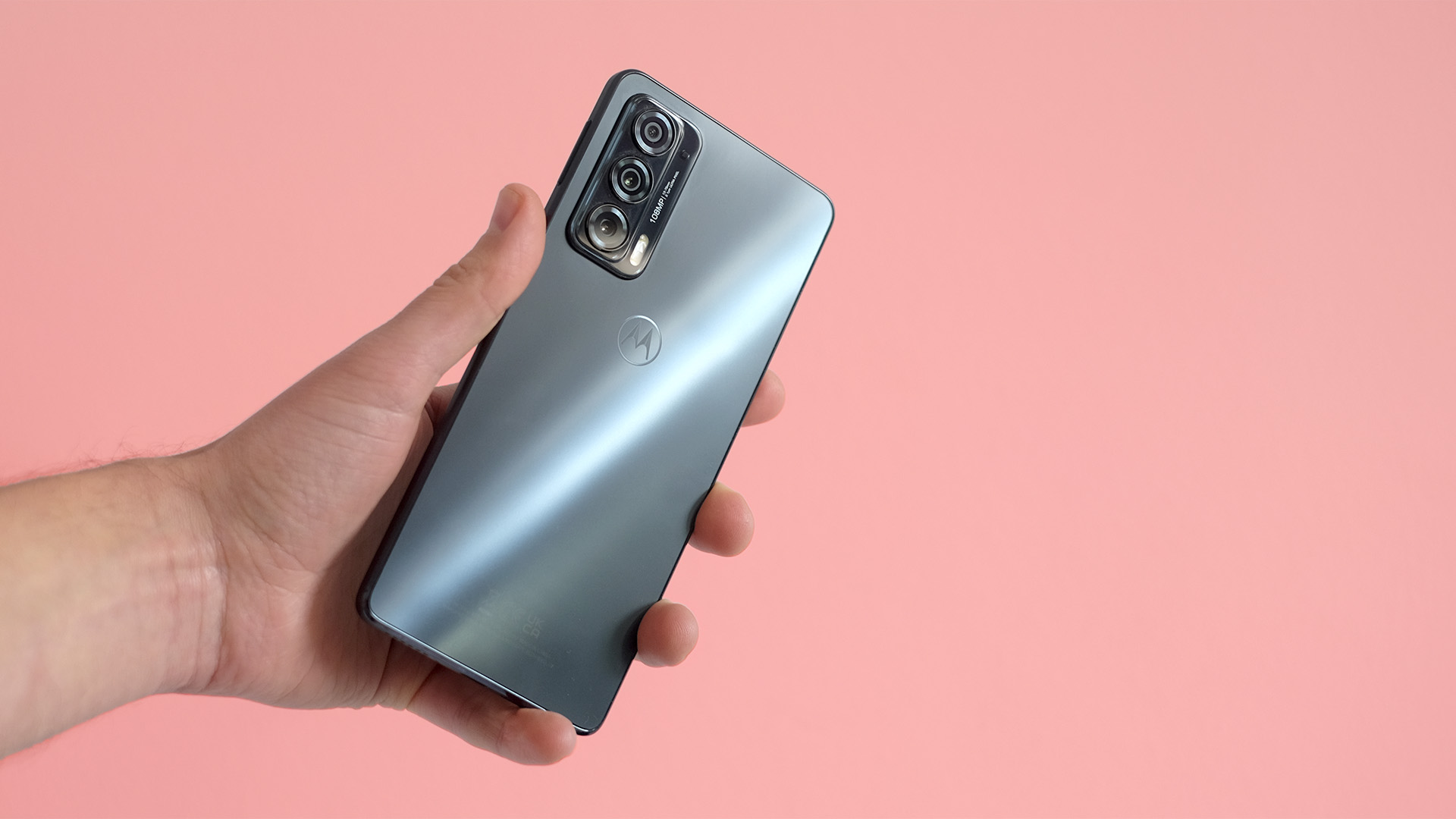TechRadar Verdict
The Motorola Edge 20 is one of the few large-screen, mid-range Androids that is both thin and light. However, the camera, speaker and battery capacity are weaker than the competition’s, narrowing its appeal a little too much for comfort.
Pros
- +
Color-rich, OLED screen
- +
Clean, smooth software
- +
Has a 3x zoom camera
Cons
- -
Small battery not a good fit for heavy users
- -
Thin-sounding speaker
- -
Far from the best camera in its class
Why you can trust TechRadar
Two-minute review
The Motorola Edge 20 is one of the thinnest phones around. This is not something we usually get to say about Motorola phones, most of which are rounded and relatively chunky.
It makes the Motorola Edge 20 a large-screen phone that doesn't feel large, which is nice. This is a flagship phone trait, but don’t come expecting a true high-end phone feel, as the back plate is plastic. And while the sides are supposedly aluminum, they feel like plastic too.
There’s some of this slightly scattergun approach elsewhere. For example, the cameras look great on paper, as you get a 3x zoom as well as an ultra-wide and a 108MP main camera. A zoom is rare at the price. However, image quality is largely unremarkable across the board. You can take all kinds of photos with the Motorola Edge 20, but few are going to blow you away.
Similarly, the large and bold 6.7-inch screen should be great for gaming. But the weak-sounding mono speaker and relatively small battery mean it's not the best choice for gamers.
When we review phones, we try to hone in on the sort of people they are a good fit for. The Motorola Edge 20 is a little too unfocused for too much of that sort of thinking.
Or, from another perspective, perhaps we're just overthinking it. Perhaps its lead design trait really is the main draw, and enough on its own. This is a really thin phone from a company that does not typically make thin phones.
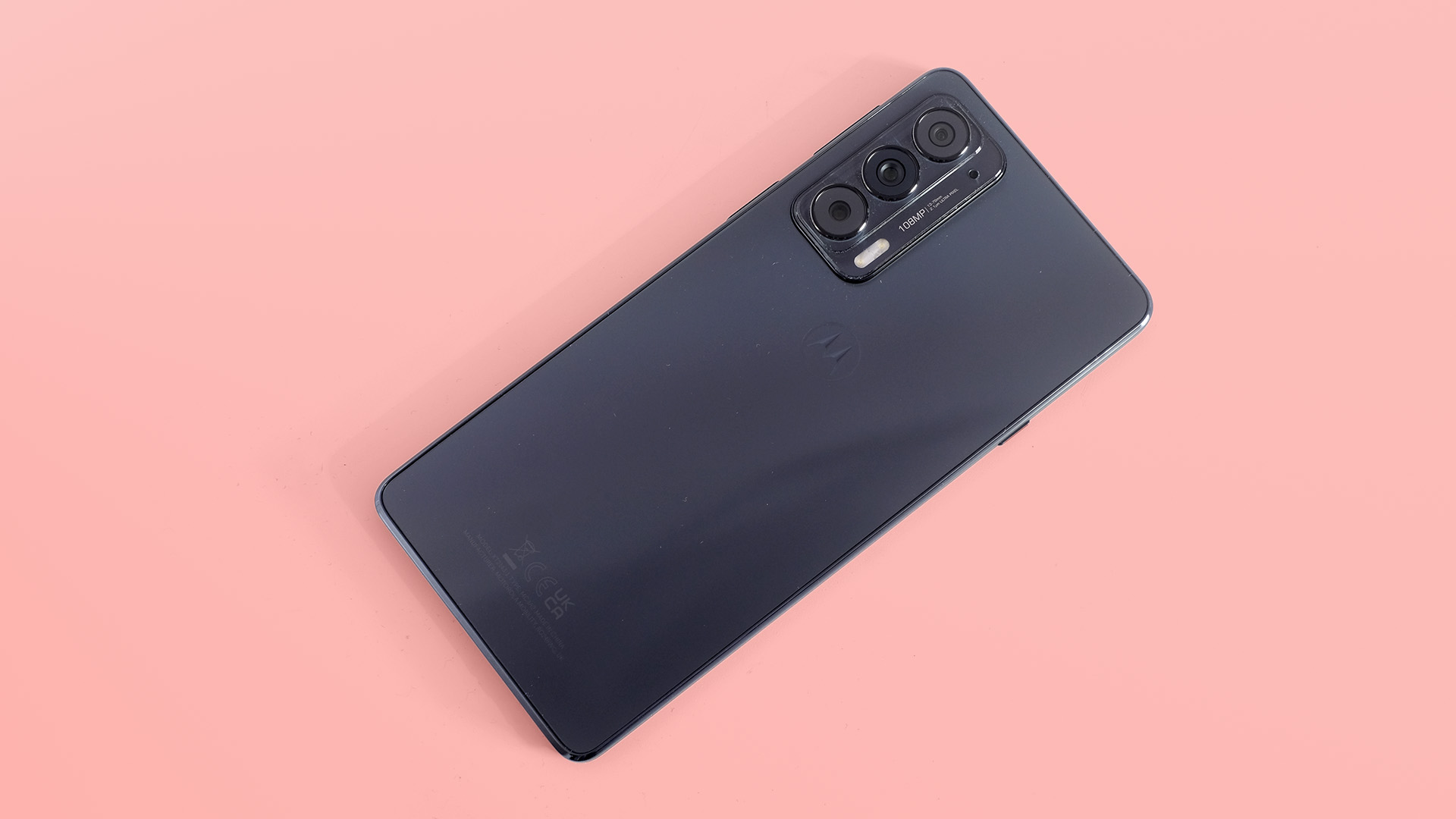
A lot of Androids with large screens at this price are chunky. The Motorola Edge 20 is not. If that sounds up your street, it’s probably a good fit. If you’re not fussed about chart-topping slimness, you may end up preferring the OnePlus Nord 2, Google Pixel 5, or one of the even more aggressively priced Xiaomi or Motorola phones.
Sign up for breaking news, reviews, opinion, top tech deals, and more.
Motorola Edge 20 price and availability
- Out now
- Costs $529 / £429 / AU$699
The Motorola Edge 20 was released in August 2021, and is a close relation of the Motorola Edge 20 Pro and Edge 20 Lite.
It costs $529 / £429 / AU$699, the middle-ground option between those two other phones.
At this price other big-name phones you might consider include the Google Pixel 5a, the OnePlus Nord 2 and the Samsung Galaxy A52 5G.

Design
- Very slim at 7mm thick
- Plastic rear, aluminum sides that feel like plastic
- Gorilla Glass 3 front
The Motorola Edge 20 is what most other Motorola phones are not: slim. It's not just thin, it's positively skinny at 7mm thick.
This is quite a departure, given that we spent a good part of 2021 reviewing budget Motorola phones over 9mm thick. The result is the Motorola Edge 20 feels about as thick as some other phones without a case when it has its supplied silicone jacket on.
Motorola seems to want you to use this case, as the Edge 20 is already dressed up in the thing in its box.
The Motorola Edge 20 gets a design upgrade in one sense, then, but it doesn't feel dramatically more high-end than Motorola's G-series budget phones. Its back is plastic, and feels like it. Its sides are - apparently - aluminum, but we'd have guessed they were plastic if every other source on the net didn't suggest otherwise.
There’s none of the classic cool-to-the-touch hardness of aluminum here, because Motorola has covered these sides in some form of paint or resin. It feels like a plastic phone, aside from the display glass, of course, which is Gorilla Glass 3.
We’re lucky to get this as a lot of lower-end Motorolas now use an unspecified, presumably cheaper, kind of toughened glass. But Gorilla Glass 3 is pretty old at this point, and for just a little more money you can nowadays get a Xiaomi 11T, which uses far superior Gorilla Glass Victus.
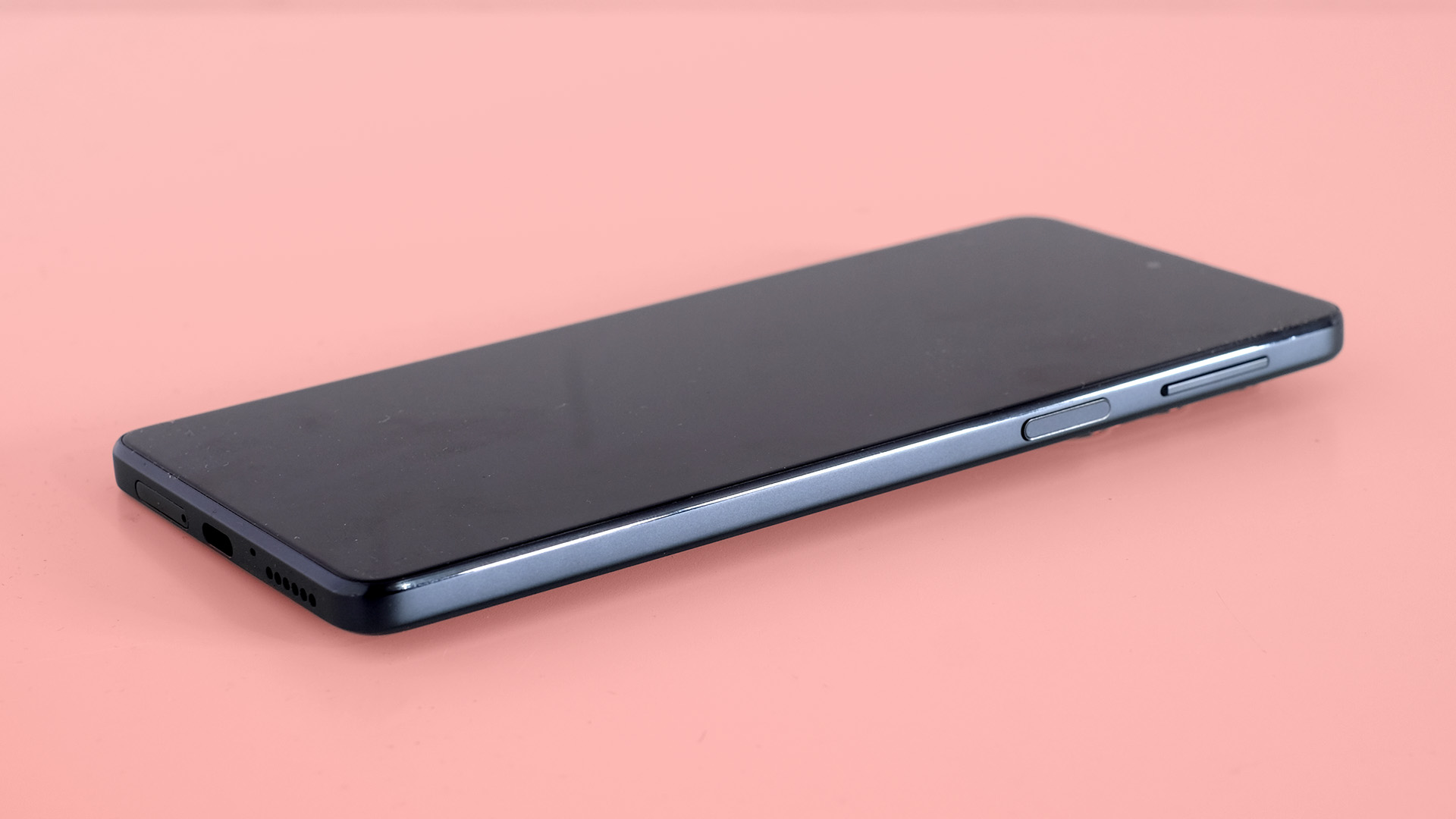
If you are tired of chunky phones, you may love the Motorola Edge 20's design. But ultimately it's nothing that impressive outside of its 7mm thickness.
We also prefer using it with the case, as without it the stick-out camera housing means it doesn’t sit flat on a table, risking damage to the lenses or, at the very least, the little rings of aluminum sitting around them. Chipping off their thin layer of black paint is a sure-fire way to make your Motorola Edge 20 look tatty.
Are we sounding grumpy right now? It may be because the Motorola Edge 20 is also an example of what you get if you try to make a super-thin phone without considering the knock-on effects.
Its speaker is quite thin-sounding, and you only get one driver down at the bottom. It is more reedy than those of some cheap Motorolas, presumably because there's no room for a speaker chamber to massage some warmth and depth into the output. The Motorola Edge 20 can go loud enough – it can make podcasts audible over the sound of a shower - but the tone is notably weaker than most phones.
The Motorola Edge 20, no surprise here, lacks a headphone jack and a microSD card slot. However, the fingerprint reader on the side is fast and reliable.
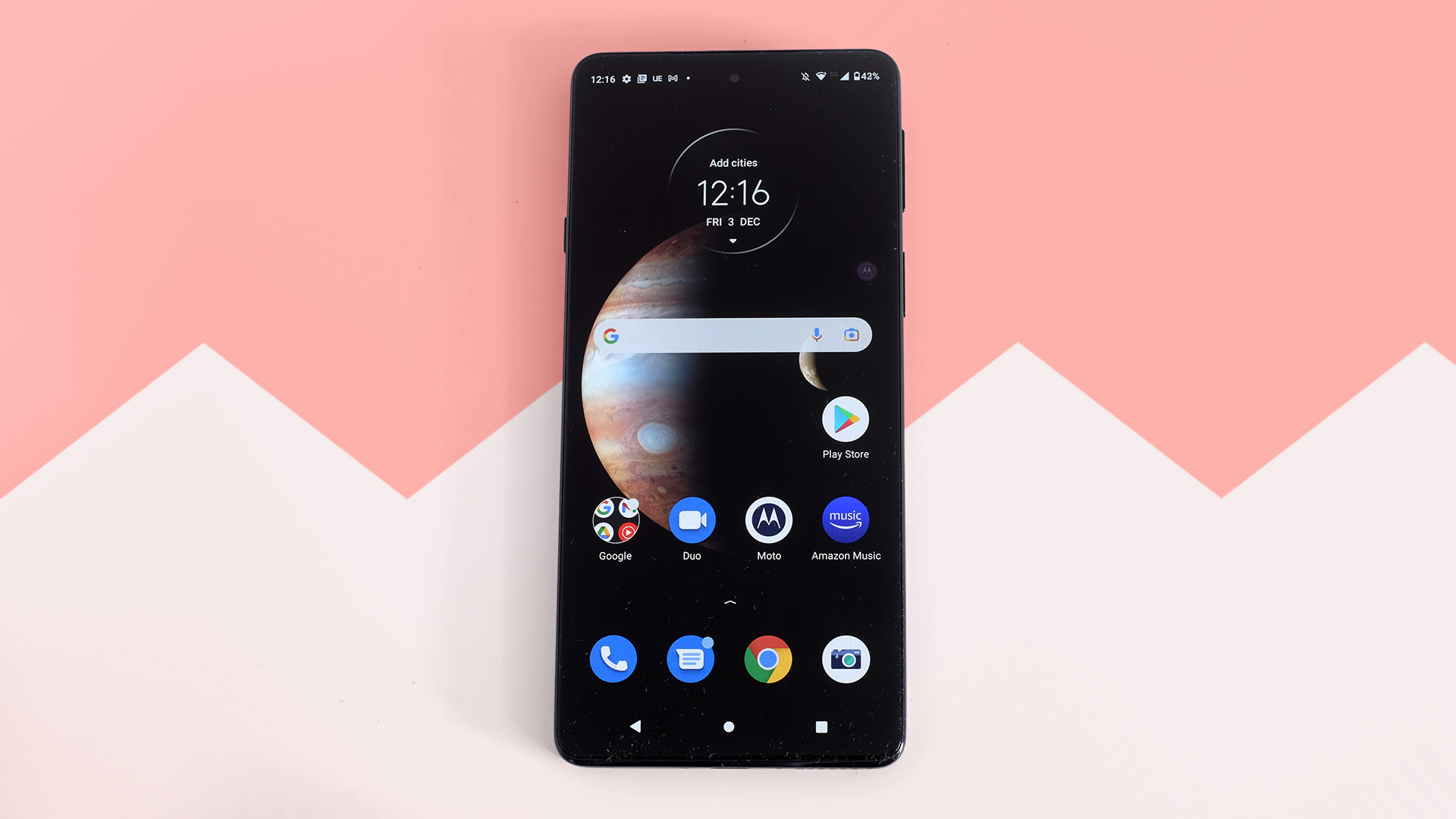
Display
- Bold OLED color and deep blacks
- Good outdoor brightness
- 144Hz refresh rate, but effectively a 120Hz screen in use
Thankfully, the Motorola Edge 20’s screen is much less of a mixed bag. It's a large 6.7-inch OLED display of 1080 x 2400 resolution. This is as sharp as you can hope for at the price, and the large surface area makes it a great canvas for YouTube videos.
OLED tech means it looks fantastic even in a dark room: not just good for YouTube, but YouTube in bed at midnight when you should be asleep rather than watching mukbang videos.
The Motorola Edge 20 even fares pretty well at the other end of the spectrum.
This phone was tested largely during November in London, amid storms and much greyness. but there was still the odd day of bright sunlight, and the Edge 20 holds up well for a phone at this level. We’re not talking about the 1000+ nits of an iPhone screen, but we haven’t seen an OLED dramatically brighter at the price.
Our one gripe here is fixable. Fresh out of the box, the Motorola Edge 20 is set to its Saturated color mode (ours was, anyway). This exhibits very vibrant reds and greens, which we found a bit much. Trust your own eyes, but we prefer the tamed Natural mode, which also has a warmer color temperature.

Motorola is likely showing off the ‘10-bit’ color reproduction of the panel here. Fair enough. But there’s a reason we have a LIFX bulb, not a stadium floodlight, in the bedroom.
The tech fans out there might have noted we haven’t even touched on what might seem like the screen’s most important feature, a 144Hz refresh rate. Yes, this is higher than the 120Hz you tend to see in a lot of value-led OLED phones that cost a similar amount. But, no, we don’t think those extra 24Hz are particularly worthwhile.
If you use the Auto refresh rate mode, and most people will as it is the default, the maximum refresh rate the screen uses is 120Hz. You’ll only see 144Hz if you set the Edge 20 to use 144Hz 24/7. And you don’t want to do that as it uses more battery power, which the phone can’t afford. So if you use this phone the right way, you’ll never even see that 144Hz refresh rate.
Switching between the two, the difference isn’t exactly vast anyway. The Motorola Edge 20 clearly has a 144Hz screen simply because affordable 144Hz panels are available. And this one is pretty darn good.
Camera
- Pretty mediocre image handling
- Has a useful 3x zoom
- Smart implementation of macro with okay results
The Motorola Edge 20 has three rear cameras. You get a 108MP primary, a 16MP ultra-wide camera and an 8MP telephoto with 3x optical zoom.
This last one is a bit of a stand-out. You usually have to spend a bit more to get a ‘real’ zoom camera. Even the Google Pixel 6 does not have one, for example.
Sometimes focusing on getting fewer things right can work better, though. None of these sensors is particularly high-end. The 108MP one is a Samsung HM2, Samsung’s lower-end 108MP sensor, with a smaller light-gathering area than either the HM3 (used in the brilliant Samsung Galaxy S21 Ultra) or the HMX, seen in the Xiaomi Mi 10T Pro.
All the other camera sensors, including the 32MP selfie camera, use relatively low-cost OmniVision hardware. So is breadth better than depth? Let’s talk strengths and weaknesses.
We’re never going to say ‘no’ to optical zoom hardware. The 3x gets you loads more close-up detail than a crop of the 108MP camera, despite the high stated sensor resolution. It is apparently optically stabilized, but we found you do have to hold the Edge 20 very still to avoid soft or, more often, fizzy-looking detail.
Zoom shots never look amazing thanks to the limited sensor quality, but in perfect lighting you can still take some just-about Instagram-worthy shots.
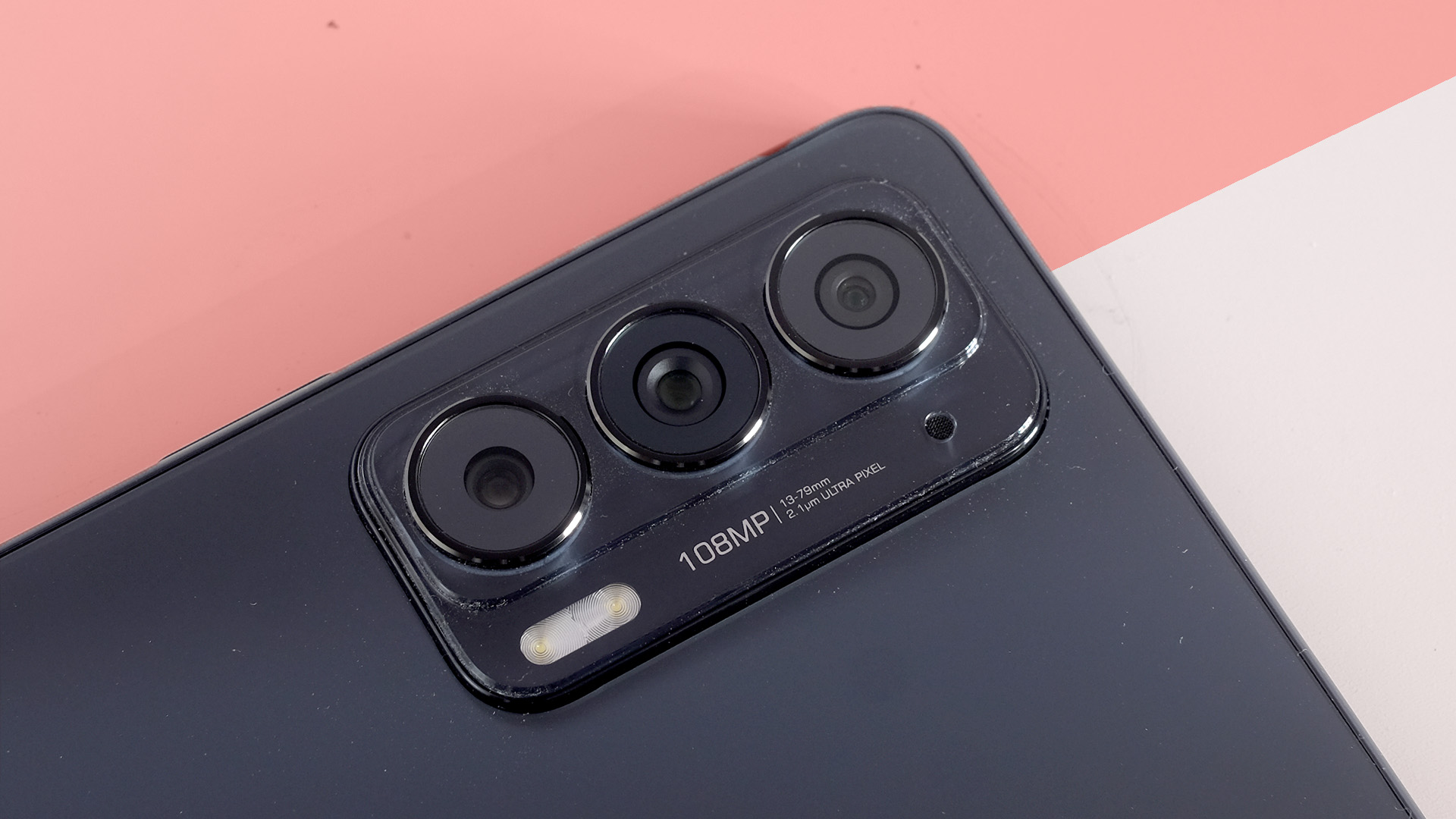
The next highlight is shared by most good phones in this class: effective HDR when dealing with bright areas in a scene.
When the Motorola Edge 20 is pushed to the max with a scene that demands very strong use of HDR, the phone sometimes captures HDR and non-HDR versions. This highlights just how much highlight detail is recovered, at the acceptable cost of slightly less realistic-looking color gradients across bright blue skies. It's nothing unusual, and makes your photography feel care-free.
Motorola also takes a sensible approach to macro - extreme close-up - photography. There’s a dedicated macro mode despite the lack of a macro camera, as it uses the ultra-wide sensor to capture images. The Edge 20 crops into the 16MP sensor’s view a bit and spits out an 8MP image.
Macro images won't win you any awards but the results are still far better than most dedicated macro cameras in lower-mid-range phones. Motorola’s execution is clever enough to make it feel as though the phone has a separate macro camera, even though it does not.
Still, the few dedicated macro fans out there will be better served by the Xiaomi Redmi Note 10 Pro's 5MP macro. It can eke out surprising amounts of true ‘macro’ detail.
The bad bits? Motorola’s handling of color, contrast and the representation of shadow areas is not in the same league as, for example, Google’s.
All our overcast images had a fairly strong magenta cast, and the foreground routinely looked too dim. This is where the Edge 20’s HDR/contrast seems lacking. It knows what to do when you put the sun in view, but starts to flounder when the light level across the image is somewhat more consistent.

Dull days look even duller through the Edge 20’s eyes, although you can make all these shots much better with a quick post-shoot edit. Color casts can be corrected, subdued shadows can be lifted.
Less can be done with the Motorola Edge 20’s night images. They simply aren't that good, much worse than the Google Pixel 4a's for example. The Night Vision mode helps a bit, but not enough. Google’s Pixel 5a and OnePlus’s Nord 2 are way ahead in this area.
Here is the Motorola Edge 20 camera in a nutshell. Its hardware lets you take a good range of kinds of image: solid ultra-wides, serviceable macros, fair 3x zooms. But Motorola needs to work on its image handling to make shots look as you’d hope they would fresh out of the camera. It currently lags behind most of the big names including ones you might not guess, like Xiaomi.
The Motorola Edge 20’s video modes are typical of Androids in the $300-450 range. You can shoot 4K video, but only at 1080p. However, it does have the part we were looking for. 4K video is stabilized, making it genuinely useful.
If you drop down to 1080p/30fps you can also switch between the main camera, ultra-wide and 3x zoom while shooting.
4K video looks great in reasonable lighting. 1080p at 30 frames per second also looks good, and the inter-lens transitions are handled well in the final footage - if you can forgive the lenses refocusing after you switch. 1080p at 60 frames per second is the weak link, as it looks noisier and less detailed than 1080p/30fps, at least in overcast London weather.
The Motorola Edge 20’s 32MP selfie camera is solid. It uses pixel binning to improve retention of detail in lower light, and if you let it use the screen as a makeshift flash you can even get passable selfies in a dark room.
Camera samples








Software
- Clean and simple interface
- Smooth general performance
- Few Motorola extras, and those here are useful
Interface style is always a good reason to choose a Motorola. Its phones are just so pleasantly free of trash apps, weird fonts and strange little design decisions clearly made to try to look different from everyone else.
The Moto lock screen is the clearest part Motorola does add, and as it’s in total lock-step with the rest of the interface in terms of look, there’s no divide here. This is the interface equivalent of a cold glass of water, or fresh air. No synthetic wafts of mall or casino air freshener here.
There are a few little functional extras, partly hidden away. Those who have already owned a Motorola may know what they are. Certain motion gestures can act as shortcuts. For example, two karate chops toggles the torch. Two twists of the phone fires up the camera. Most others are switched off by default, but can be turned on in the Moto app.
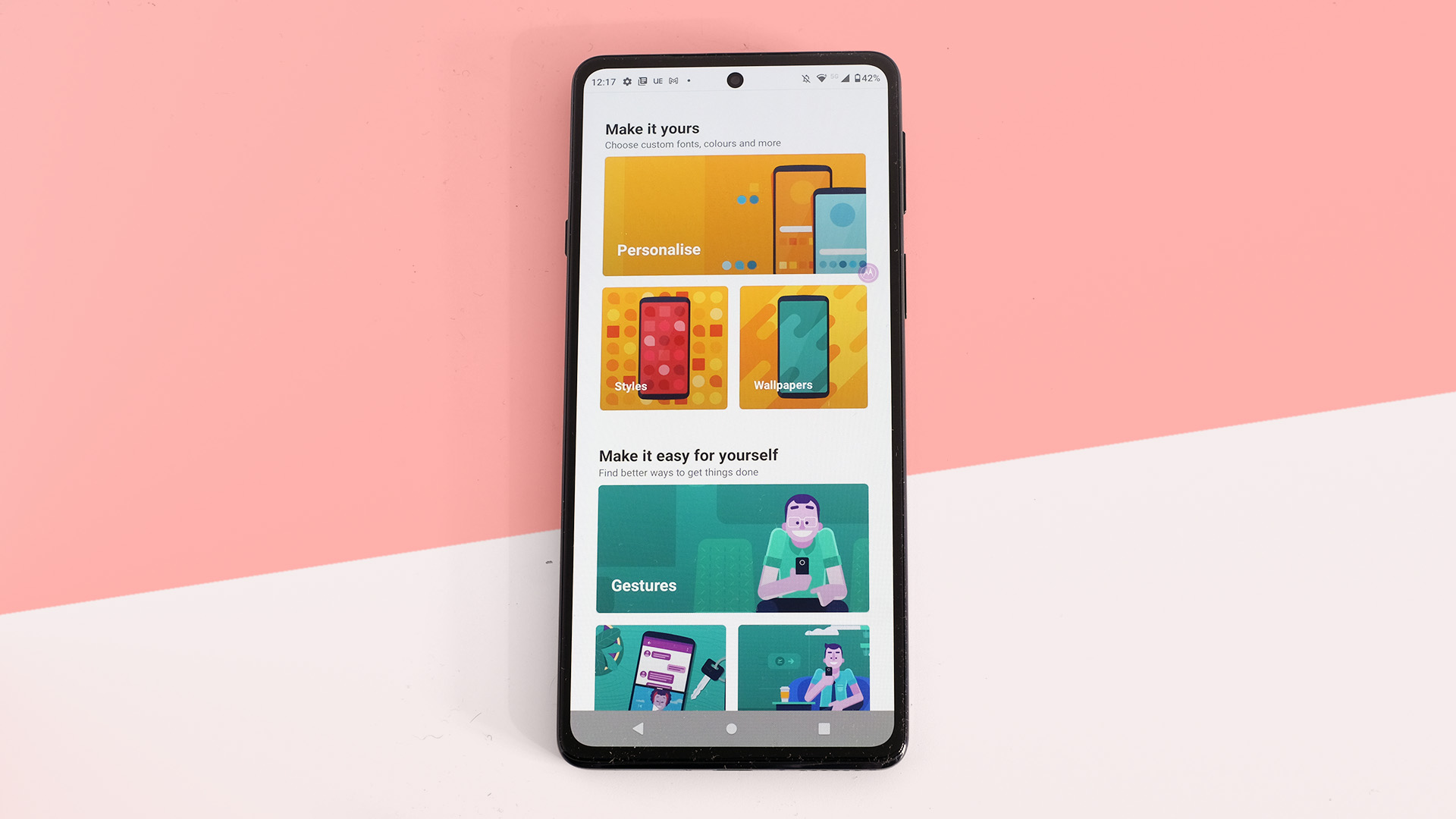
We often say a lack of bloat is one of the Moto appeals, that there’s not much more added than the ‘Moto’ app. However, our Edge 20 also came with a bunch of other apps pre-installed, like AliExpress, Amazon Music and Amazon Shopping.
Perhaps they’ll be there for you too. Perhaps we accidentally selected them somehow during the setup wizard. Either way you can uninstall them. Getting upset about this stuff is a waste of energy.
We also saw no significant performance issues with general use. No obvious lag, no slow loading of apps or egregious glitch-outs. Smooth sailing, just as we like it. The phone has 8GB of RAM, and 128GB of storage.
Performance and gaming
- Very good mid-range processor
- Mid-table gaming performance
- Mono speaker is a drawback for play
The Motorola Edge 20 has a Snapdragon 778G chipset. A stack of phones have used it, including the Honor 60, the Samsung Galaxy M52 5G (released in India) and the Galaxy A52s.
That Samsung uses the same processor in a similarly priced phone tells us we’re getting at most an okay deal. It's no Realme GT in the price-to-performance stakes.
However, the Edge 20 does not seem a phone made particularly with games in mind. It doesn't have stereo speakers or a huge battery, and that we have not noticed any performance problems suggests the Snapdragon 778G is a perfectly good fit.
But how do games run? Perfectly well for a phone in this class, although not always markedly better than phones $100/£80 or so less.

Fortnite will only play in its 30fps mode - the 60fps mode is only unlocked for select high-end phones. It spends most of the time at 30fps, but there are occasional drops into the teens as big areas are revealed when you peek over a hill or turn around quickly.
This seems more a case of assets being loaded into RAM awkwardly rather than the Edge 20's GPU actually struggling to render the scene, as the frame rate typically jumps right back to 30fps.
The Motorola Edge 20 scores 2,745 points in Geekbench 5. This is only a few hundred points off the Snapdragon 888. However, its graphics performance is only half that of Qualcomm’s high-end CPU, resulting in a 3D Mark Wild Life score of 2,502 (a Snapdragon 888 phone might score 5,300).
Battery life
- Small battery: last a day, not great for heavy users
- Charges in 61 minutes
- 30W charger included
The Motorola Edge 20 has one of the smallest batteries among Motorola phones, at 4,000mAh. It’s smaller than the Edge 20 Lite's 5,000mAh, and lower capacity than the Pro version's 4,500mAh.
This hasn't resulted in the sort of calamity we feared. The Motorola Edge 20 usually manages to last a full day without issue even if it never has much charge left by 11pm - which you will often get with the company’s lower-end G-series phones. This suggests Qualcomm’s Snapdragon 778G is, like most of its mid-range processors, fairly easy on the battery.
The Motorola Edge 20 has had the advantage here, though. Reviewing a phone in autumn/winter when rising Covid rates mean you’re barely leaving the house is different to doing so in the middle of summer when you’re out and about a few times a week.
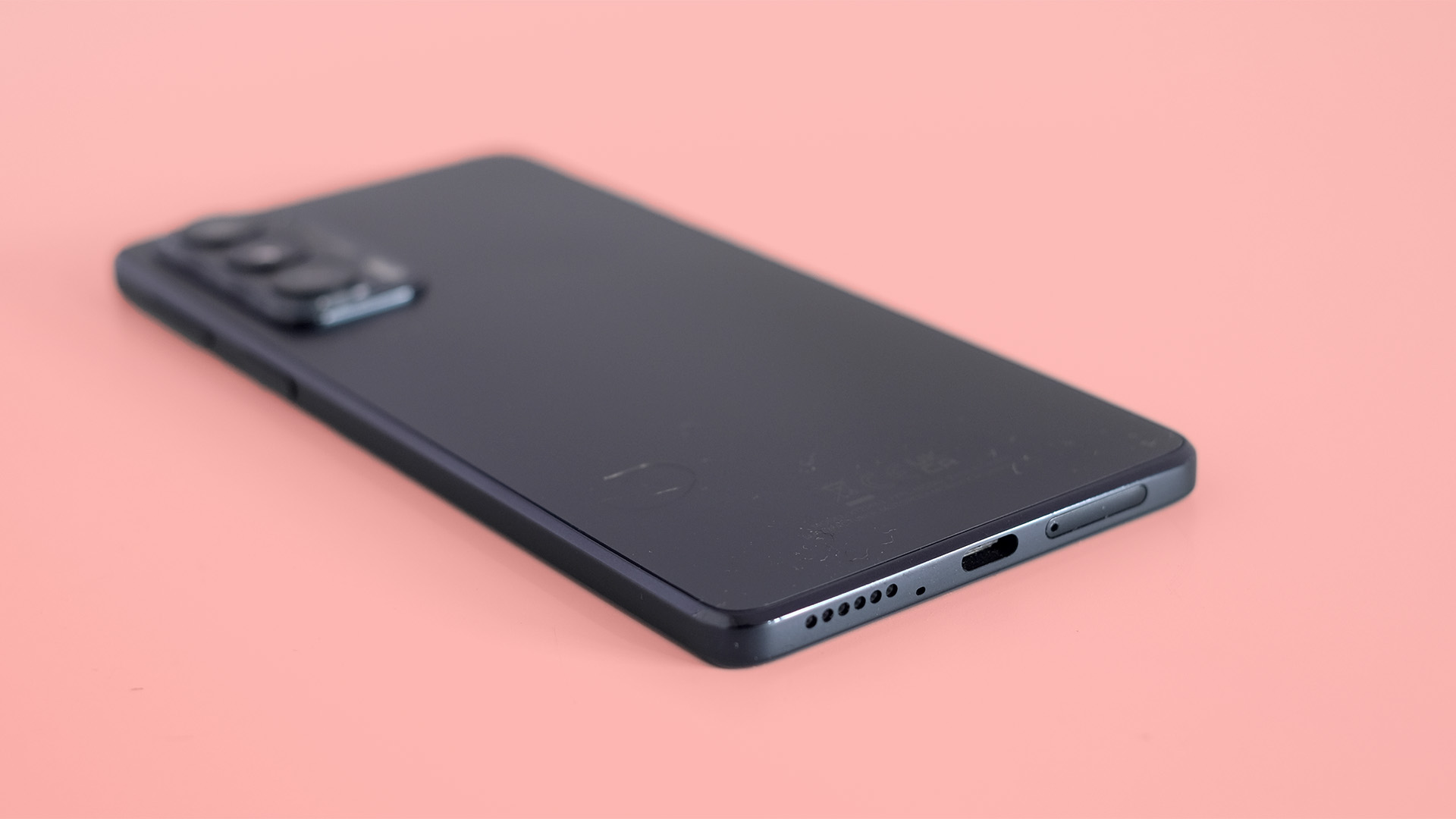
This phone does not have the kind of battery buffer that lets it sail through a day of moderately heavy use, and this is something to consider.
The Motorola Edge 20 uses a 30W charger with a USB-C to USB-C cable. Oddly enough, this is actually a slower charging system than is used by the cheaper Motorola G60S, which has a 50W charger.
Real-world charging speeds are decent, though. You get from flat to 41% in fifteen minutes, and to 76% in half an hour. A full charge takes 61 minutes, those last few percent taking their sweet time to arrive.
Should you buy the Motorola Edge 20?
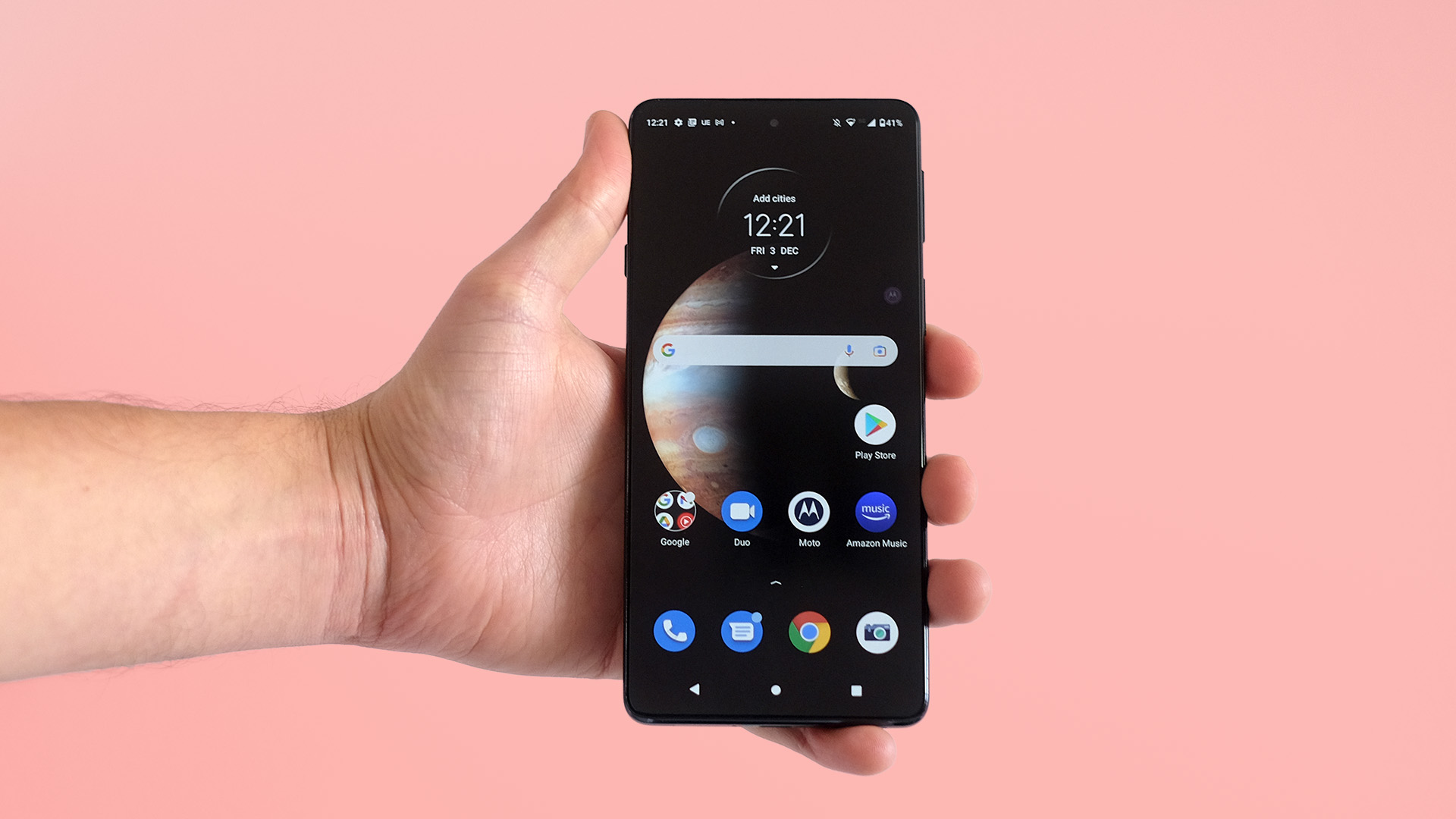
Buy it if...
You’d like a slim phone
You're likely to get on with the Motorola Edge 20 if you want a large-screen phone but are tired of big-screen Androids that feel like pocket-filling slabs. This one is much slimmer at 7mm. Its boxy shape is very different to those of the G-series phones, but still makes the Edge 20 unusually easy to handle for a 6.7-inch screen mobile.
You're desperate for an optical zoom
While the Motorola Edge 20 does not have remotely class-leading cameras, it does have something other rivals do not: an optical zoom. This is a 3x zoom camera that captures 8MP photos, letting you get closer to the action without... actually getting closer to the action.
You want a large, colorful screen
The Motorola Edge 20 has one of the better displays found at the price. It's a 6.7-inch OLED with rich color, perfect blacks, good maximum brightness and 1080p-grade sharpness. No complaints here: it makes everything from web pages to games look good.
Don't buy it if...
You use your phone a lot each day
The Motorola Edge 20 has a somewhat low capacity battery thanks to its thin casing, at 4,000mAh. Many other Motorolas have 25% extra capacity. As a result, you don’t get much of a buffer to take you into a second day of use. While we haven't found this too annoying, we wouldn’t trust it to last a long, heavy day where you need to use the phone outdoors a lot, pushing display brightness up.
You want class-leading photos
This camera array looks great on paper. It has a zoom, a wide, a macro mode and a 108MP sensor. However, colors are often a bit off, shots can appear dull and the phone doesn't perform well at night. For more consistent image quality, cameras that look worse on paper, like the Pixel 5a, are better.
You’re a big mobile gamer
The Motorola Edge 20 can play popular games like Fortnite well. However, a few elements of a top class gaming phone are missing. The speaker is mono and sounds thin (if quite loud). The battery capacity is a bit low to accommodate gaming sessions, and there are simply phones with more powerful GPUs available if you're a performance hound.
First reviewed: December 2021

Andrew is a freelance journalist and has been writing and editing for some of the UK's top tech and lifestyle publications including TrustedReviews, Stuff, T3, TechRadar, Lifehacker and others.
